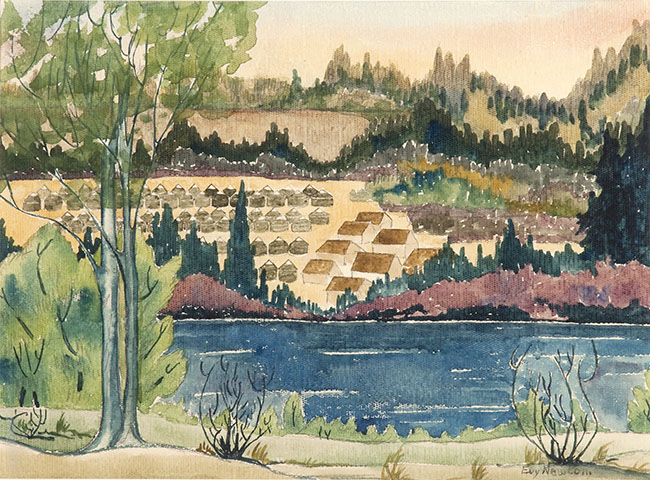This week, our thoughts turn to remembrance, honouring both Indigenous Veterans Day (Nov 8) and Remembrance Day (Nov 11). In recognition of these days of remembrance, we are honoured to feature two artworks from the AFA Art Collection produced by Euphemia McNaught and Evelyn McBryan.
These two paintings from 1942 "Army Camp, Charlie Lake" by Evelyn McBryan and "US Army Camp Sept. Charlie Lake BC" by Euphemia McNaught, capture a single, pivotal moment in Canada's WWII history. They depict the U.S. Army camp at Charlie Lake, B.C., a hub for one of the most significant engineering projects of the war, the construction of the Alaska Highway.
In the aftermath of Pearl Harbour, Canada played host to over 10,000 U.S. soldiers that arrived in the north to build this critical inland supply route. Receiving an unprecedented commission directly from Prime Minister Mackenzie King, McNaught and McBryan, were two of the only civilians—and women—granted official permission to enter the highly restricted military zone. They became unofficial war artists. While not on the front lines they documented the construction of this massive, high-speed military project.
Dedicated to completing their commission the duo would go as far to disguise themselves as men, as women weren’t permitted on the sites they needed to access. Together, McNaught and McBryan were able to produce 34 paintings from 1942 to 1944.
But this is not the only story.
What the works also depict is the arrival of thousands of soldiers on the traditional lands of the Dene, Saulteau, Kaska, and other First Nations. Completion of this monumental project, built in response to the threat of invasion, would not have been possible without the key knowledge of Indigenous guides, trappers, and community members. They were the ones who knew the "unexplored" terrain, the muskeg, and the river crossings, enabling the U.S. Army to navigate the challenging northern landscape.
The Alaska Highway project would forever alter these unceded lands affecting the Indigenous communities and wildlife that called the area home.
As we look at these paintings, we see a layered history. We honour all who served and sacrificed in times of conflict. We remember the soldiers who built this highway and the artists who documented it, the critical role of Indigenous peoples and the impact of the highway forever changing the landscape.
About the Artworks
The Alaska Highway Series consists of 34 paintings and was a cooperative effort between Euphemia McNaught and Evelyn McBryan. During 1942 to 1944, both artists travelled along the Alaska Highway as far as the Sikanni River, documenting through sketches and paintings the construction of the highway.
About the artists
The relationship between Euphemia "Betty" McNaught and Evelyn "Evy" McBryan was a multi-layered, lifelong connection that began with McNaught as the teacher and McBryan as her art student in the Peace River region. This mentorship evolved into a close personal friendship and a significant professional collaboration. Together, they became the foundational figures of their local art scene, establishing the Beaverlodge and Grande Prairie Art Clubs. Their most famous project is the commission from Prime Minister Mackenzie King in 1942.


